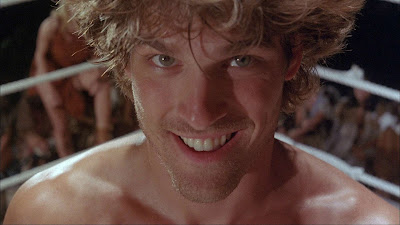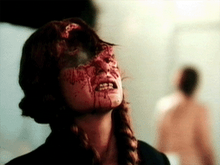The week began with my wife in the emergency room and continued with the lawless fascist cretins running the country destroying due process and ignoring court orders, so I really needed the 85-minute dose of undiluted stupidity and fun that was Deathstalker II: Duel of the Titans.
The first Deathstalker was a Roger Corman-produced Conan the Barbarian rip-off that had a reasonable b-movie sense of humor about itself but mostly played things straight. The sequel is a defiantly silly parody of the first movie and sword-and-sorcery fantasy in general, directed by Chopping Mall's Jim Wynorski (a b-movie legend whose career stretches from 1984's The Lost Empire to last year's DinoGator), with Chopping Mall's John Terlesky taking over as Deathstalker and Penthouse Pet Monique Gabrielle (my wife: "You know that if an actress is named Monique Gabrielle you're going to see her boobs") in a dual role as deposed princess Reena the Seer and her evil doppelganger Princess Evie, the latter conjured by evil sorcerer and usurper of the throne Jarek (Beyond the Valley of the Dolls' John LaZar) ("This is my happening and it freaks me out!"). This is a fine example of HYBC (Hell Yeah Brother Cinema) because when you see it, you say, "Hell yeah, brother!" (That's a Mid-Atlantic-era Ron Bass "brother" and not a Hulk Hogan "brother." Hulk Hogan sucks.)
Like the first film and most other sword-and-sorcery movies, Deathstalker II contains a beefcake hero, sword battles, epic quests, black magic, a deposed court, a formidable but cowardly villain who has stolen the throne, lots of bare skin, horseback riding, and unappetizing stews eaten in huts. Unlike those movies, this one also has zombies, a bar open 24 hours, a pro wrestling match between our hero and Gorgeous Ladies of Wrestling star Queen Kong, more one-liners than a Naked Gun movie, a 100 percent increase in the first movie's number of pig-men from one to two, and a hero who looks like he just got back from organizing a frat kegger instead of living in an ancient mythical era.
Terlesky, who is now a successful television director, is the epitome of the chisel-chinned, smirking '80s prep-school jock and could not look more mid-1980s if he tried. His casting lets you know right away that Wynorski is not playing it straight. Terlesky even keeps his '80s hairstyle, looking more like an asshole in a John Hughes movie than Conan on a budget. He leans into his '80s dudeness and plays the part as a wisecracking party guy in it for the babes and the glory who can rise to the heroic occasion when circumstances call for it. Most of his one-liners aren't particularly hilarious, but the quantity of them is funny. It's the dad-joke ratio. The numbers are what's important. Resistance is futile.
His romantic interest/mythic quest partner Gabrielle is legitimately funny in her dual good/evil roles. Most of these Playboy and Penthouse sex bomb pictorial stars turned actors have a wooden presence onscreen when required to do anything besides being sexy, but Gabrielle has a natural goofiness, silliness, and warmth that work perfectly for this movie.
Weirdly, John LaZar, who gave one of the great unhinged performances in Beyond the Valley of the Dolls as Z-Man, is relatively subdued here as the evil sorcerer, but you totally buy him being an evil sorcerer anyway, especially if you're familiar with his Z-Man work. Still, I wanted LaZar to go wilder in this. (Also, his doppelganger magic potion subplot is inexplicably dropped in the final third.)
The movie opens with Deathstalker fighting some masked swordsmen in a castle and occasionally taking five to kiss a woman we never see again. After a narrow escape from Jarek's feminine counterpart Sultana (Toni Naples), Deathstalker leaps out of a castle window onto a horse and rides away. Sultana leans out the window and says, "I'll have my revenge, and Deathstalker, too!" Bam! The opening credit title card hits. Hell yeah, brother.
Deathstalker stumbles across more masked castle guards giving Reena the business on his way to the 24-hour bar, Abud's, and decides to intervene. He lets them know that he's not completely opposed to manhandling women if they deserve it, but he doesn't like what they're doing to this woman. (Has Deathstalker gone woke?) He beats up the guards, except for the last one, who runs away with the great line, "Leave me alone, I don't even know these guys."
Finally making his way to Abud's, Deathstalker has somehow picked up two babes on the quick jaunt over and is ready for some beer drinking, hand over candle tomfoolery, and an eventual threesome in a room upstairs. He gets cockblocked by a massive bar fight and rides away with Reena, who followed him into the bar and talks her way onto his horse. She takes him to her hut and reads his fortune while feeding him unappetizing stew. She says he will become famous and wealthy if he undergoes a brutal quest to defeat Jarek. Deathstalker loves the wealthy part and starts the quest immediately. Reena tags along, not revealing that she used to be the princess. Something tells me these two kids are going to earn a grudging respect for each other and maybe, just maybe, fall in love.
What follows is 70-plus minutes of nonstop action, horniness, wisecracks, and insanity that should entertain anyone who is not made of stone. Our heroes fight Sultana's henchmen and their exploding arrows, zombies in a graveyard, a wall of moving spikes in a mausoleum, a sexy Amazon tribe and their queen (Maria Socas) who inexplicably have a wrestling ring and force Deathstalker to wrestle Gorgo (Dee Booher aka Queen Kong) to the death and who also inexplicably break the match into rounds like it's boxing (the Amazons later become allies), unwanted marriage proposals, steaming hot water tubs, swinging axes, castle guards, Princess Evie (who can eat men's souls after booty calls and turn their bodies into weird masks that hang on her headboard), Sultana, and Jarek.
Deathstalker II works as both a low-budget sword-and-sorcery movie and a low-budget comedy. These Conan knock-offs are usually relatively entertaining, but a lot of them take themselves so seriously. Wynorski foregrounds the humor that is already inherent in scantily clad beefcakes and buxom babes fighting magical weirdos and mythical beasts with swords while also keeping all the stuff you like from the more straightforward fantasy epics. This is also probably the only sword-and-sorcery movie that ends with a blooper reel. I had a great time and was never bored.



























